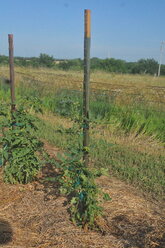 Soils are warm enough now that tomatoes can benefit from mulching. Tomatoes prefer even levels of soil moisture and mulches provide such by preventing excessive evaporation. Other benefits of mulching include weed suppression, moderating soil temperatures and preventing the formation of a hard crust on the soil. Crusted soils restrict air movement into and out of the soil and slow the water infiltration rate. Hay and straw mulches are very popular for tomatoes but may contain weed or volunteer grain seeds. Grass clippings can also be used but should be applied as a relatively thin layer – only 2 to 3 inches thick. Clippings should also be dry as wet clipping can mold and become so hard that water can’t pass through. Also, do not use clippings from lawns that have been treated with a weed killer until some time has passed. With most types of weed killers, clippings from the fourth mowing after treatment may be used. If the lawn was treated with a product containing quinclorac (Drive), the clippings should not be used as mulch. If the weed killer used has a crabgrass killer, it likely contains quinclorac. (Ward Upham) 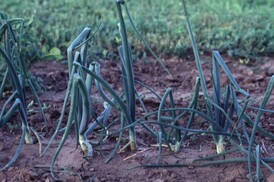 This is the time of year that onions grow and develop rapidly. Regular watering (if needed) and a light fertilization are helpful to maximize growth. If your soil tends to be alkaline, use ammonium sulfate (21-0-0) at the rate of ½ cup per 10 feet of row. Or you can use a lawn fertilizer such as a 29-5-5, 27-3-3 or anything similar but only use 1/3 cup per 10 feet of row. Make sure the lawn fertilizer does not have a weed preventer or weed killer included. Sprinkle the fertilizer 2 to 3 inches alongside the row and water in. Do not fertilize after the onions start to bulb. Onions develop so that as much as 2/3 of the bulb remains out of the soil. There is normal and there is no need to cover the bulb with soil. (Ward Upham) 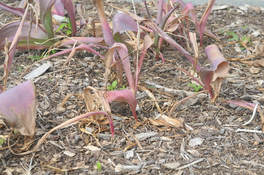 It is important to leave spring-flowering bulb foliage in place until it “ripens” or becomes brown. The energy produced by the leaves after flowering is transferred to the bulb so that it can flower the following year. The ripening process should be near completion now for tulips, daffodils and various other spring-flowering bulbs. Use clippers, scissors or even a mower to remove dead foliage. Also, try to map out where the bulbs are planted as there will be no foliage to make the location next fall when it is time to fertilize. (Ward Upham) 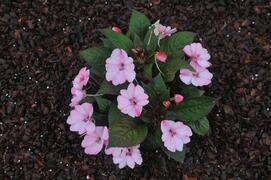 Gregg Eyestone, Horticulture Agent from Riley County, has put together a nice chart that covers sidedressing nitrogen on annual flowers, certain perennial flowers, vegetables and various small fruit. Sidedressing (also called topdressing) is applying nitrogen fertilizer as plants are growing to give them an extra boost. Done correctly, sidedressing can improve vegetable, fruit and flower production. Gregg lists the crop, the amount of fertilizer needed, and suggested time of application. Rates are given for ammonium sulfate, urea and blood meal. You may find the chart at http://tinyurl.com/hxtgres (Ward Upham) 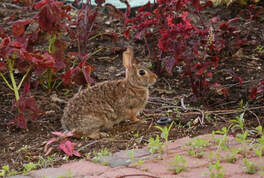 Most people enjoy the wide variety of wildlife found in Kansas until that wildlife becomes a nuisance or damages property. Charlie Lee, K-State Wildlife Management Specialist, has put together a web site on wildlife management at http://www.wildlife.k-state.edu/ . Species covered include everything from bats to woodrats. Each species page also incorporates quick links for more in-depth information. One of our most common pest species, moles, includes videos on tracking an active tunnel and setting a mole trap. This site is an excellent resource for the various options of dealing with our interactions with wildlife in a safe and effective manner. (Ward Upham) 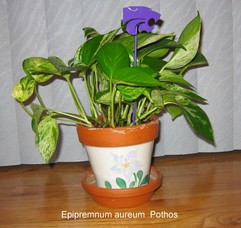 We are approaching the time of year when many people take vacation. In the rush to get everything done before leaving, don't forget your houseplants will probably need watering while you are gone. The best alternative is to have someone water them for you. However, if this is not possible, there are alternatives. 1. Well-watered plants can be placed inside a plastic bag. Prop up the bag by using wooden dowels or something similar to keep the plastic off the leaves. Make sure the enclosed plants will not receive full sun as heat buildup may cook them. Bright, indirect light is best. Plants should keep for about a week with this method. 2. This method requires an old dish drying rack, a bathtub in a bathroom with some natural light and some shoelaces. Place the drying rack upside down in the tub and add several inches of water. Push one end of a shoelace through a drainage hole on the bottom of a pot and into the potting soil of your houseplant. The other end of the shoelace dangles into the water. What you have made is a wick system that will replace water in the pot as the plant uses it. Plants can last a couple of weeks if you have enough natural light. 3. There are numerous commercial products that can be used to automatically water houseplants in your absence. The advantage of these products is that the houseplant does not normally need to be moved. All require a reservoir from which water is either siphoned or pumped to individual houseplants. Houseplants should last as long as the water holds out. (Ward Upham) 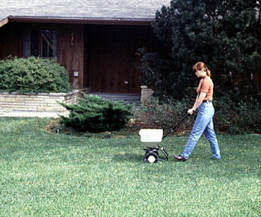 June is the time to fertilize warm-season lawn grasses such as bermudagrass, buffalograss, and zoysiagrass. These species all thrive in warmer summer weather, so this is the time they respond best to fertilization. The most important nutrient is nitrogen (N), and these three species need it in varying amounts. Bermudagrass requires the most nitrogen. High-quality bermuda stands need about 4 lbs. nitrogen per 1,000 sq. ft. during the season (low maintenance areas can get by on 2 lbs.). Apply this as four separate applications, about 4 weeks apart, of 1 lb. N per 1,000 sq. ft. starting in early May. It is already too late for the May application, but the June application is just around the corner. The nitrogen can come from either a quick- or slow-release source. So any lawn fertilizer will work. Plan the last application for no later than August 15. This helps ensure the bermudagrass is not overstimulated, making it susceptible to winter-kill. Zoysiagrass grows more slowly than bermudagrass and is prone to develop thatch. Consequently, it does not need as much nitrogen. In fact, too much is worse than too little. One and one-half to 2 pounds N per 1,000 sq. ft. during the season is sufficient. Split the total in two and apply once in early June and again around mid-July. Slow-release nitrogen is preferable but quick-release is acceptable. Slow-release nitrogen is sometimes listed as “slowly available” or “water insoluble.” Buffalograss requires the least nitrogen of all lawn species commonly grown in Kansas. It will survive and persist with no supplemental nitrogen, but giving it 1 lb. N per 1,000 sq. ft. will improve color and density. This application should be made in early June. For a little darker color, fertilize it as described for zoysiagrass in the previous paragraph, but do not apply more than a total of 2 lb. N per 1,000 sq. ft. in one season. Buffalograss tends to get weedy when given too much nitrogen. As with zoysia, slow-release nitrogen is preferable, but fast-release is also OK. As for all turfgrasses, phosphorus and potassium are best applied according to soil test results because many soils already have adequate amounts of these nutrients for turfgrass growth. If you need to apply phosphorus or potassium, it is best to core aerate beforehand to ensure the nutrients reach the roots. (Ward Upham) 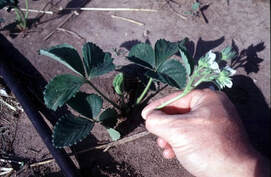 Spring-bearing strawberry plants that were set out this spring should have blossoms pinched off. New plants have a limited amount of energy. If blossoms remain on the plants, energy that should go to runner development is used to mature fruit instead. Plants that are allowed to fruit will eventually produce runners, but those runners will not be strong enough to produce a good crop of berries the following year. For an adequate strawberry plant population and a good crop next year, early runner development is necessary. Early runners will produce far more strawberries than runners that form later in the season. Newly planted everbearing plants also should have fruits removed for the first 4 to 6 weeks after planting so they develop a strong root system. (Ward Upham) |
AuthorsCynthia Domenghini runs the Horticulture Response Center in the Department of Horticulture and Natural Resources at Kansas State University. Other contributors include K-State Extension Specialists. Archives
March 2024
Categories
All
|
| K-State Research and Extension Horticulture Newsletter |
|
 RSS Feed
RSS Feed
